July 24, 2012
I guess I’m fickle, since I found a new fancy today—an overnight sail to Ravenna and Bologna, and now I’m infatuated with those two Italian cities.
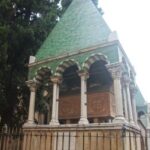
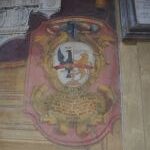 Bologna claimed my allegiance because it is the home of the first university in Europe—1088 was the origin of a school of anatomy and law (religion, apparently, was too serious to be left to the universities). Today, it houses 90,000 students, which is staggering in a city of 500,000. Fortunately, the school was in recess, so the traffic rather resembles Bloomington Normal in July—rather light. We exited the bus at the tombs
Bologna claimed my allegiance because it is the home of the first university in Europe—1088 was the origin of a school of anatomy and law (religion, apparently, was too serious to be left to the universities). Today, it houses 90,000 students, which is staggering in a city of 500,000. Fortunately, the school was in recess, so the traffic rather resembles Bloomington Normal in July—rather light. We exited the bus at the tombs 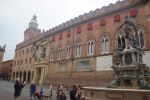
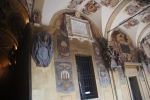 of the first three professors, which are impressive indeed, from the days when professors were esteemed. Furthermore, in the old library, faculty got to create and draw their own coat of arms, another European idea that would look pretty neat on the IWU campus—if we couldn’t build buildings that looked like they were from the 14th century!
of the first three professors, which are impressive indeed, from the days when professors were esteemed. Furthermore, in the old library, faculty got to create and draw their own coat of arms, another European idea that would look pretty neat on the IWU campus—if we couldn’t build buildings that looked like they were from the 14th century!
The most impressive building to me was an old castle, that after one of the many wars, became a palace with a new façade, constructed over two time periods, on one side. I never before realized the difference between Romanesque and Gothic (especially flaming Gothic) until I saw them side by side—rather plain, square, and ornate arches and circles over the windows.
One amusing and sort of frightening event. I was engrossed in the faulty 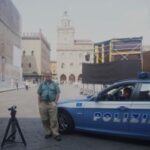 coat of arms, but saw that our tour director from the boat was equally absorbed. However, when we were ready to leave, we realized our guide had taken our group to the lunch stop. The Ukrainian tour director spoke no Italian, but we flagged down a police car. One of the officers had been born in New York (he said he was the only English speaker on the force). He called the boat, found out where our lunch was, and took us to the restaurant. Happily, I did not have to spend the rest of my life in Bologna.
coat of arms, but saw that our tour director from the boat was equally absorbed. However, when we were ready to leave, we realized our guide had taken our group to the lunch stop. The Ukrainian tour director spoke no Italian, but we flagged down a police car. One of the officers had been born in New York (he said he was the only English speaker on the force). He called the boat, found out where our lunch was, and took us to the restaurant. Happily, I did not have to spend the rest of my life in Bologna.
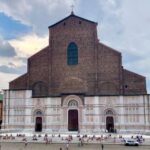
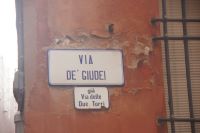 The other building worth going to Bologna to see is a massive cathedral, partially finished, in Gothic style, that the people of Bologna wanted to raise the money for themselves, and raised enough to start building the cathedral. They wanted it big, and it was so big that the Pope intervened and said that no church can be bigger than St. Peter. It was never finished, but the city’s residents have exhibited some liberal tendencies (it was a hub of the communist party after World War II, and there were some terrorist bombings in the 60s and 70s). The church is also renowned for a painting picturing Mohammed in hell, a picture which after 9/11 has the church under tight security (that along with the recent earthquake which closed a number of sites for repair).
The other building worth going to Bologna to see is a massive cathedral, partially finished, in Gothic style, that the people of Bologna wanted to raise the money for themselves, and raised enough to start building the cathedral. They wanted it big, and it was so big that the Pope intervened and said that no church can be bigger than St. Peter. It was never finished, but the city’s residents have exhibited some liberal tendencies (it was a hub of the communist party after World War II, and there were some terrorist bombings in the 60s and 70s). The church is also renowned for a painting picturing Mohammed in hell, a picture which after 9/11 has the church under tight security (that along with the recent earthquake which closed a number of sites for repair).
Bologna is around 60 miles inland from Ravenna, the city where our boat 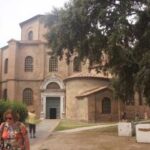
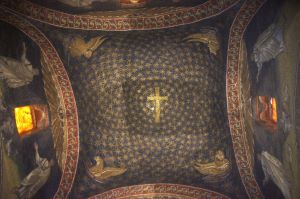 was docked (actually, the city was on the Adriatic in Roman times, but the ocean had filled in, and it now sits 6 miles or so from the port). I was interested in Ravenna for its historical importance: after the split of the Roman Empire between Constantinople and Rome, the Romans eventually moved the capital to Ravenna, which was far easier to defend against the northern tribes. It was, in fact, the last capital of the Roman Empire. Theodoric I, an Ostrogoth, conquered the city and added
was docked (actually, the city was on the Adriatic in Roman times, but the ocean had filled in, and it now sits 6 miles or so from the port). I was interested in Ravenna for its historical importance: after the split of the Roman Empire between Constantinople and Rome, the Romans eventually moved the capital to Ravenna, which was far easier to defend against the northern tribes. It was, in fact, the last capital of the Roman Empire. Theodoric I, an Ostrogoth, conquered the city and added 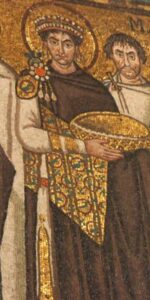
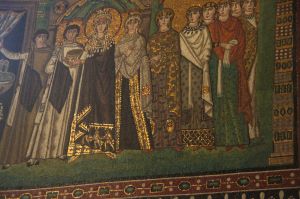 something different to it: a form of Christianity that held Jesus was not one of the trinity, but the son of God. That sort of doctrinal challenge to Catholicism, branded Arianism, was banished at the Council of Nicea in the 4th century, but some of the sites in Ravenna managed to escape the order to destroy all Arian churches and mosaics.
something different to it: a form of Christianity that held Jesus was not one of the trinity, but the son of God. That sort of doctrinal challenge to Catholicism, branded Arianism, was banished at the Council of Nicea in the 4th century, but some of the sites in Ravenna managed to escape the order to destroy all Arian churches and mosaics.
The two (of eight) UNESCO sites we visited were not Arian, but had what art historians argue is the best preserved Byzantine icons. One set was in a church, where it portrayed the Byzantine Emperor who restored (Eastern) Roman rule, Justinian, and his wife, Theodora, whose accession from dancer to Empress scandalized the Christian world (The Empire became Christian when Constantine converted early in the 4th century). The bits of colored glass put together to depict Christianity, so characteristic of Byzantium, are among the best preserved in the world, and almost 8 centuries earlier than those in Hagia Sophia in Istanbul.
How I wish I had spent more time in Ravenna than in Bologna, but at least I have seen both.
We’re at sea on our way to my next favorite—Dubrovnik.